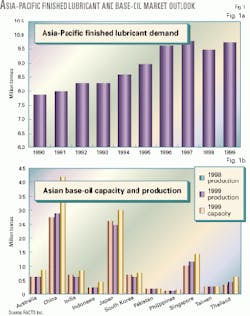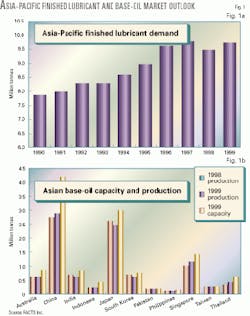Demand for Asia-Pacific lubricant base oils will grow by 4%/year to 2010. The expanding lubricant sectors in China and India will largely fuel this growth, according to a study by market analyst FACTS Inc., Honolulu.
The study predicts that base-oil demand will not equal regional supply until 2004, as a result of a capacity overhang that grew to 1.8 million tonnes/year prior to Asia's economic crisis.
During Asia's precrisis period, 1990-96, Asia-Pacific lubricants demand rose 2.5%/year before peaking at 9.9 million tonnes in 1997 (Fig. 1a). After the crash of the Asia-Pacific lubricants market, regional demand fell by 4%. Malaysia, Thailand, and South Korea each experienced a 20% decline in sales. Indonesia, Singapore, and the Philippines each had decreases of 6-14%.
"The regional decline would have been far more damaging were it not for demand growth of 150,000 tonnes/year from China and India during this period," the FACTS study noted.
"Burgeoning lubricant sales in these two countries offered a much-needed home for production from the region's new base-oil refineries, which backed out traditional imports from Atlantic Basin refiners."
Fig. 1b breaks down the 1998 Asia-Pacific base-oil production and 1999 production and capacity by country.
"Asia-Pacific lubricant demand is expected to grow by more than 50% to 15.5 million tonnes in the coming decade. Its prospects should remain more promising than traditional fuels markets, which continue to suffer from increasing commoditization," FACTS said.
"With margins normally averaging 15-20% after costs, it's little wonder that many companies looking to create value in their downstream operations have looked in this direction. Yet, one must remember that perception and marketing are paramount in securing market share, and the path to these margins is a hard-earned trail that cannot be gained access to overnight."
China, India
Over the next decade, China is expected to remain Asia's key growth market and will account for more than 40% of the volumetric increase in regional lubricants demand. China's continuous growth during the economic crisis offered a much-needed buffer for base-oil producers.
"In recent years, base-oil imports have shifted from direct purchases by the state oil companies to transfer shipments by foreign blenders now operating inside China," FACTS said. "This trend is expected to persist as state refiners focus on better utilization of their own capacity and improving base-oil quality, which could someday be used to service growing demand from foreign blenders.
"Until these supplies are available, foreign blenders will rely on imports. This presents obvious opportunities for base-oil producers [because] foreign imports may total 550,000 tonnes/year by 2005 if they maintain current market share."
India will be the other source of growth, with sales increasing by 5.2%/year through 2010. Asian base-oil refiners have been very successful in displacing imports to India from European producers over the past several years, with shipments from Singapore totaling 295,000 tonnes in 1999, FACTS noted.
Better utilization and possible additions of existing base-oil capacity may allow Indian refiners to acquire a larger piece of local blending requirements in the future.
Malaysia
Malaysia is now the only country threatening the recovery of the regional base-oil market, the FACTS study said.
State oil company Petronas is contemplating whether to construct a new base-oil refinery at Malacca. If the proposed plant comes on stream in 2002-03, Southeast Asia's surplus will be extended for several more years.
Construction of the new plant will back out much of the 150,000-200,000 tonnes/year of base oil imported every year into Malaysia that would need to find a new home somewhere else.



